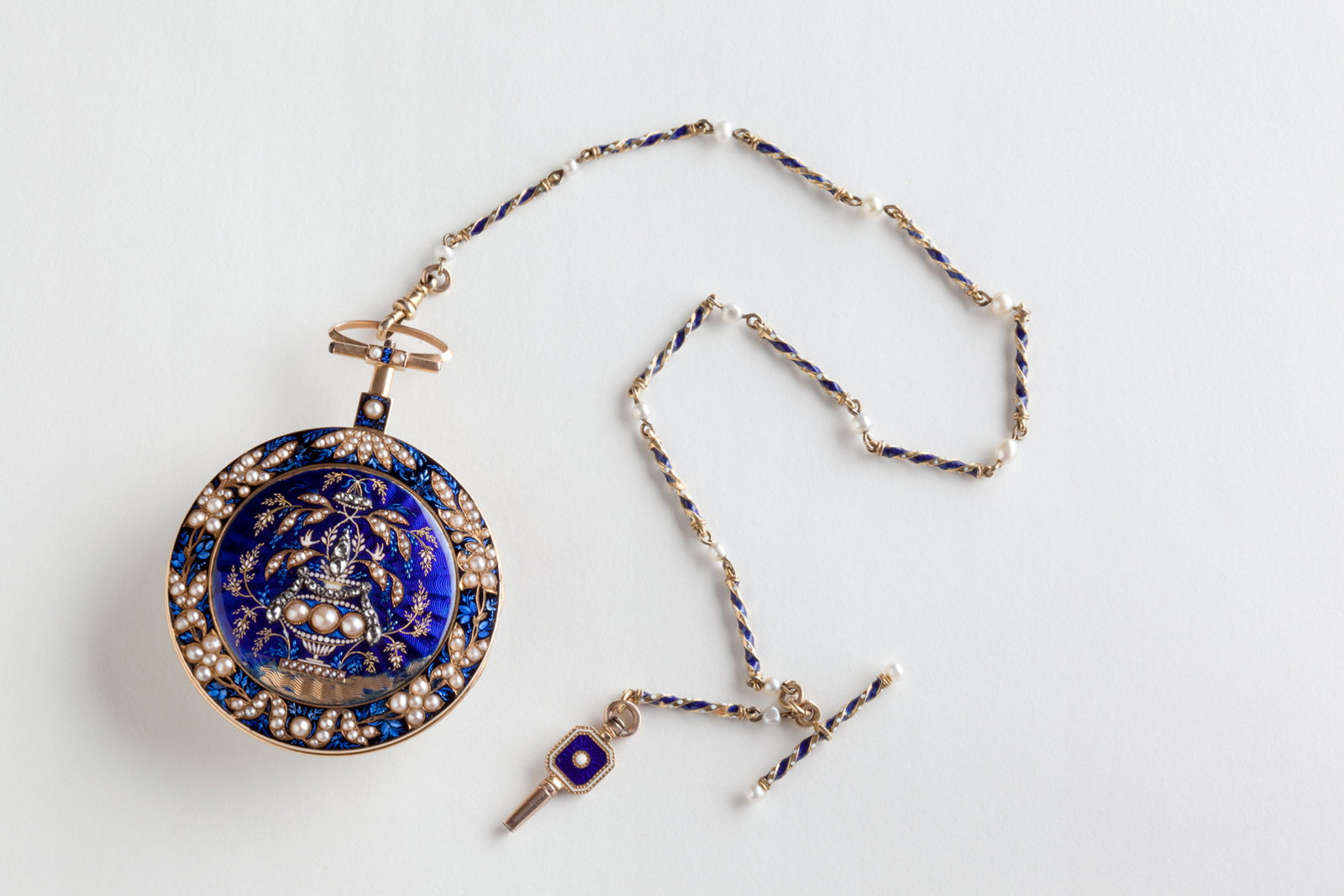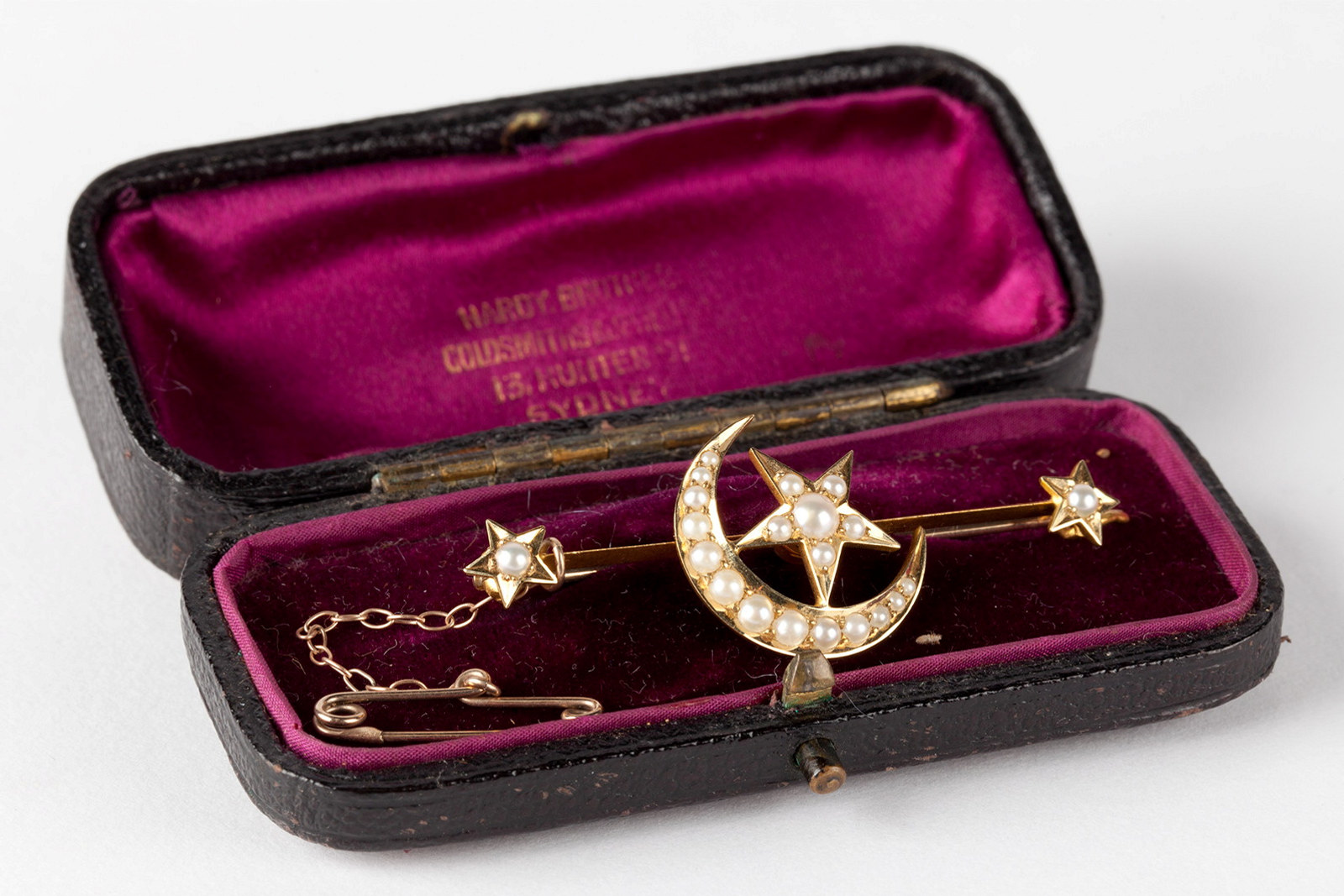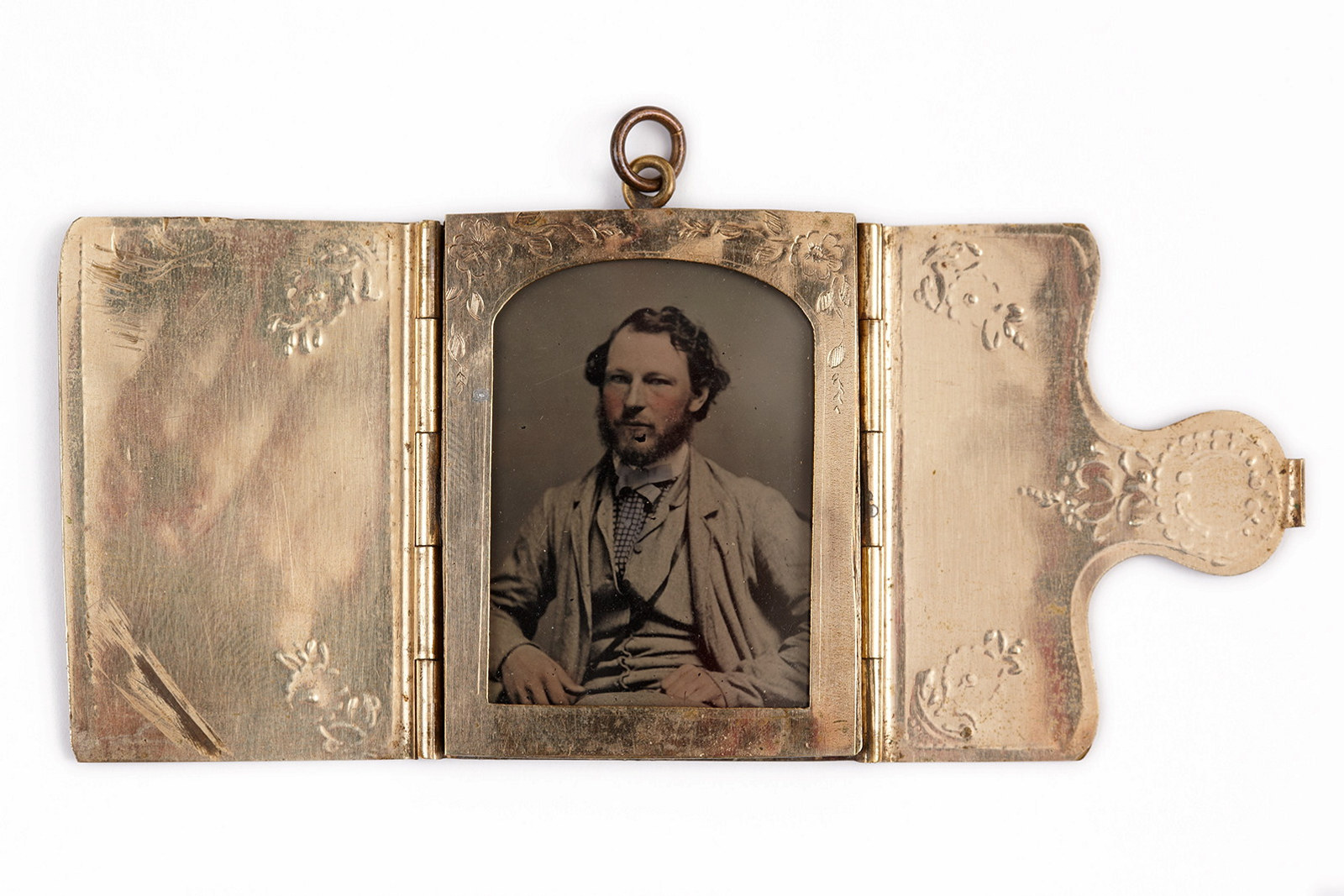Keeping time
In the eighteenth and nineteenth centuries watches were designed to carried on the person, attached to a waist hook, looped over a belt or as part of a chatelaine in the case of women, and dropped into the pocket of a waistcoat when worn by a man.
They were usually cased in gold or silver, often engraved with the owner’s monogram, and sometimes a crest or inscription. The pocket watches in the collections of Museums of History NSW range in date from a late eighteenth century watch that once belonged to Governor Lachlan Macquarie, to a watch presented to a police inspector on his retirement in 1935. By that time the pocket watch had become old-fashioned, superseded by the wristwatch.
'Bunny’ Shepherd’s cycling trophy An article of finery Edwin Stephen Rouse’s pocket watch Hugo Youngein’s pocket watch Inspector Ruffels’ retirement watch
'Bunny’ Shepherd’s cycling trophy
When Percival (Bunny) Shepherd (1887-1949) won the New South Wales Cycling Union’s road race, the Finlay Mile, in November 1906, he was given this gold watch as a prize. It comes with a little leather pouch and is monogrammed with the initials PS on the engine turned case back. In 1906 nineteen-year old Bunny was one of the stars of the Balmain Cycling Club. He went on to join the NSW Police in 1911 and was stationed first at Balmain police station, then at Newtown. Tragedy struck the keen cyclist in 1912 when he was knocked from his bike on King Street, Newtown, by a bolting horse. He suffered severe injuries to his head and back. Although he went back to work once he had recovered he was forced to abandon cycling. He became a popular traffic policeman and was dubbed ‘Sydney’s super-policeman of traffic corners’ by one Sydney newspaper. Many years later he took up cycling again and even managed to ride to Windsor in 1940 to visit to an old acquaintance. Bunny retired from the NSW police in 1945.
An article of finery
This highly decorative fob watch once belonged to William Charles Wentworth (1790-1872), early Australian explorer, author, barrister, landowner, and statesman. It is an early nineteenth century watch, wound in the French style through the white enamel dial. The bezel is set with a circle of half pearls and the case back is decorated with translucent royal blue enamel over an engine turned ground and embellished with half pearls and rose-cut diamonds in a floral design. The gold oval pendant with its attached watch chain, buttonhole fastener and key is also decorated with pearls and blue and white enameling. Wentworth may have bought the watch while living in London in 1816-1824 where he was studying for the bar at the Middle Temple. The details of the acquisition have been long since lost and the watch itself was lost for many years. It came to light in 1957 following the death of Wentworth’s granddaughter, Miss Dorothy Wentworth (1873-1956) when her trustees found that her house was packed with family treasures, some hidden under floorboards. The watch was discovered in a secret drawer of an escritoire.

Edwin Stephen Rouse’s pocket watch
This pocket watch carries the monogram ESR for Edwin Stephen Rouse (1849-1931). It also carries a London silver hallmark with a date letter for 1864. At that time Edwin Stephen was just fifteen years old and had recently inherited Rouse Hill House, the Rouse family property established in 1813 by his grandfather Richard Rouse in the Parramatta district of New South Wales. Edwin Stephen, his siblings, and his parents Edwin and Hannah Rouse, had been living at Rouse Hill House since late 1855. Although the watch has a London hallmark it also has a local Australian maker’s name on the dial: ‘T. Jones, Sydney’. T. Jones was Timothy Tillotson Jones (1819-1897), a goldsmith and jeweller born in Islington, London, where his father was also a jeweller. He emigrated to New South Wales in the mid-1850s with his wife Bathsheba and young family and established a business in George Street, Sydney, which in due course became T.T. Jones & Sons, watch and clockmakers.
Hugo Youngein’s pocket watch
According to family stories Hugo Youngein (1859-1930) looked at this silver pocket watch every day, opening and closing the doors of his small cash grocery shop in The Rocks, Sydney, by the time it kept. The shop operated from the front room of number 64 Gloucester Street from 1904 until Hugo’s death in 1930. During the early years of the business Hugo worked as a coal lumper while his wife Clara ran the shop and cared for the couple’s four young children. After they separated around 1917 Hugo ran the grocery himself, although sometimes during the late 1920s when construction work for the Sydney Harbour Bridge became too noisy and messy Hugo would shut up shop and catch a tram to his daughter’s house in Haberfield. The small jade fish trinket attached to the gold Albert chain of the watch is believed to relate to Hugo’s earlier career as a sail maker. He had been born Hugo Knut Ljunggren (or Lyunggren) in Kalmar, Sweden, and arrived in New South Wales in 1887. Like many foreign sailors he never returned home.
Inspector Ruffels’ retirement watch
This Swiss-made pocket watch in an engine turned gold case carries the monogram AJCR of Arthur James Colyer Ruffels (1876-1953). Ruffels was born at Colyer’s Leigh near Moss Vale and worked as a gardener and groom before he joined the NSW Police in 1901. He enlisted at the Belmore Police Barracks and later said his first job was to help demolish the building in preparation for the construction of the new Central Railway Station. He spent most of his subsequent career working in Newtown, Annandale and Petersham, rising through the ranks from Probationary Constable to Inspector 2nd Class. When he retired in 1935 he proudly proclaimed that he had never taken a single sick day and that he also had an ‘absolutely clean record sheet’ – clean forgetting that he had been admonished in 1905 for not reporting that a probationary constable had been fighting ‘civilians’. After such a long and almost spotless career it is understandable that this small matter slipped his mind. Throughout his life he was a keen gardener and was popular with his colleagues who presented him with this gold watch upon his retirement as a mark of their esteem.
Lieutenant Watts’ watch
This is a late 18th century gold pocket watch with a movement made by the renowned English watchmaker Paul Philip Barraud (1752-1820) set in a case crafted by London watchcase maker Valentine Walker. It belonged to Governor Lachlan Macquarie and is engraved with the Macquarie coat of arms and motto Turris fortis mihi Deus [God is my tower of strength]. In January 1819 Macquarie presented the watch to his former aide-de-camp Lieutenant John Cliffe Watts (1786-1873) of the 46th Regiment, on the eve of Watts’ departure from New South Wales. Watts had lived at Government House Sydney with the Macquaries and had become a close family friend. Macquarie publicly acknowledged Watts’ service, describing him as ‘combining the utmost correctness of military duty with every kind and grateful interest of family regard and private friendship’. He was also commended for his ‘important extra service…voluntarily rendered to the Colony at large’ including his architectural designs for public buildings such as the Military Hospital on Flagstaff Hill and several buildings at Parramatta. Watts returned to Australia in 1841, this time to South Australia where he was appointed Postmaster General, a position he held until his retirement in 1861.
Magistrate Jennings’ retirement watch
When Chief Stipendiary Magistrate Charles Jennings (1861-1939) retired from the bench in November 1926 he was presented with this gold watch by his colleagues in the legal profession, the occasion duly caught on camera. The watch is hallmarked Rotherham & Sons, Birmingham, with a date letter for 1922 but the dial carries the name ‘Edward, Glasgow’ for George Edward & Sons, goldsmith and silversmiths, Buchanan Street, Glasgow. The case back is engraved with Jennings’ monogram. Jennings started working for the New South Wales Department of Justice at the age of seventeen. After some time at the Central Police Court in Sydney he held positions in regional areas including Forbes, Bathurst, Parramatta and Newcastle and was appointed a state coroner in 1908. Outside of the law courts he represented New South Wales in Rugby Union and was part of a touring side to New Zealand in 1892. Responding to the farewell speeches given at the Central Police Court on his retirement he declared that the ’jury system had lost its significance’ and that the pensions paid to magistrates were inadequate.
The Bong Bong Picnic Races pocket watch
This silver cased half-hunter pocket watch, with Swiss hallmarks but engraved John Hulbert, London, is monogrammed with the initials of George Alan Terry (1871-1957) of the Box Hill estate near Windsor. George Terry received this watch for winning the two-mile Welter at the Bong Bong Picnic Races on his grey gelding Nihilist in January 1894. The pair also won the Ladies’ Bracelet and came third in the Ladies’ Mile. George was a dedicated horseman, competing at picnic races and as an amateur on metropolitan racecourses. Box Hill even had its own racecourse - greatly improved by George - where Nihilist and other horses were trained and sports days and race meetings were held. George was a keen sportsman, serving as president of the Rouse Hill Cricket Club and master of the Sydney Hunt Club. His improvements at Box Hill following his marriage to Nina Rouse in 1895 included a billiard room over the stables with a billiard table ‘regarded as one of the finest in the State’. His Maxwell motor car was ‘well known as the fastest car in the Windsor district’.
Trooper Walker’s reward
This gold pocket watch was presented to ‘Bro. A.B. Walker’ by the Sons & Daughters of Temperance of NSW for Walker’s bravery in capturing the bushranger Thunderbolt on 25 May 1870. Constable Alexander Binning Walker (1847-1929) became a poster boy for the Australian temperance movement, his actions seen as proof that ‘alcoholic stimulants [were] not required to give a man dash and pluck’. The contest between Constable Walker and the bushranger Thunderbolt is a legendary chapter in Australian policing history. Walker had pursued Thunderbolt on horseback through the bush, exchanging fire with him as they rode. The battle came to a head at Kentucky Creek near Uralla where Thunderbolt declared he’d rather die than surrender. Walker responded ‘It’s you and I for it’ and charged at his foe. They fought in the water until Walker finally overpowered and killed the bushranger. Walker received an immediate promotion to Senior Constable and two months later was further promoted to Sergeant. He spent the rest of his career in the NSW Police, retiring as Superintendent in 1912, regarded by the communities he served as a cool, determined and brave man.
William Bucknell’s watch
This 18 carat gold quarter repeating watch in an engine turned case with curb chain, seal and key, also comes with its original invoice. The invoice describes the watch in detail, including its duplex escapement, fusee and second hand dial. The account is made out to colonial politician and landholder William Charles Wentworth (1790-1872) and the vendor is William Bucknell (c1777-1856). Bucknell was a watch and clock maker who established a business in London’s jewellery district Hatton Garden in 1810 and later moved to Parliament Street, Westminster. In 1817 he married William Charles Wentworth’s cousin, Martha Wentworth, at Drumcree church, near Portadown in County Armagh, Ireland. Wentworth was living in London from 1816 until early 1824 while he was studying for the bar at the Middle Temple. His agreement to purchase the watch seems to have been made on the eve of his return to New South Wales and the invoice records that Wentworth settled his account in February 1825. By that time Bucknell had decided to emigrate to Australia. He and his family sailed from Plymouth bound for Sydney in April 1826.

Related

Baubles, brooches & beads
We wear jewellery as articles of dress and fashion and for sentimental reasons – as tokens of love, as symbols of mourning, as souvenirs of travel

Close to the heart
Expressions of love and endearment have long been embodied in keepsakes or jewellery worn or held close to the body
Published on